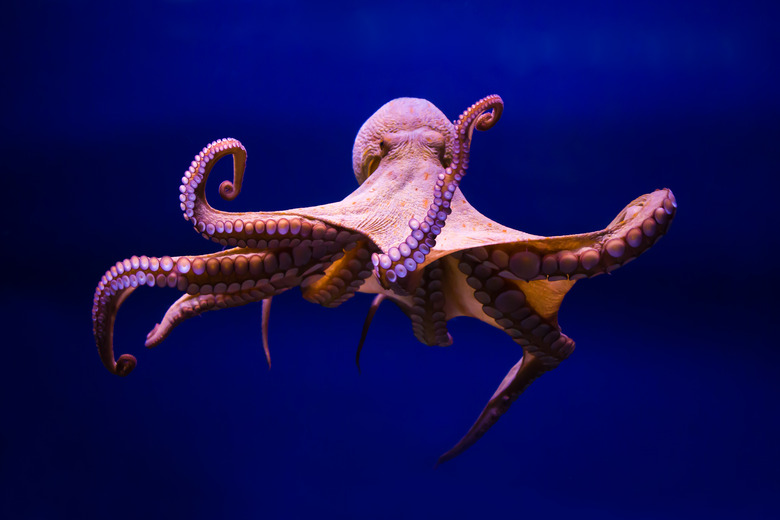Types Of Octopus
Octopus belong to the Cephalopoda class, which also includes species such as squid, cuttlefish and nautilus. More than 300 different types of octopus exist. They can be found in oceans all over the world in both shallow and deep water. The most common octopus that people are generally interested in are the common Atlantic octopus, giant Pacific octopus, blue ringed octopus and the reef octopus.
Common Atlantic Octopus
Common Atlantic Octopus
The common Atlantic octopus has a large bulbous head and eight long tentacles, much like any other octopus. It differs from all other octopi because of its elaborate defense and predator-avoiding skills. Its most striking skill is its ability to hide from plain sight in the blink of an eye. The common octopus has a network of pigment cells rooted in its muscles that can change the color of its skin to match its surroundings instantly. If it's discovered by a predator, it squirts a cloud of ink to obscure the predator's vision, giving itself time to make an escape. In the worst-case scenario, if the common octopus is caught, it will severe its own tentacle to to distract the predator and regrow it later.
The common Atlantic octopus frequents shallow, temperate waters all over the Atlantic Ocean. It feeds on crabs, shell fish and mollusks, and can grow up to 3 feet. It is also considered the most intelligent of all octopi.
Giant Pacific Octopus
Giant Pacific Octopus
The giant Pacific octopus is one of the largest octopi known to exist, growing up to 16 feet in length and weighing up to 110 lbs. Like the common Atlantic octopus, these octopi can easily blend with their environment using a network of pigment cells. They are nocturnal hunters, feeding mostly on fish, lobsters, shellfish and sometimes even birds. They're highly intelligent; according to the National Geographic Society, tests have revealed them capable of solving puzzles, performing tasks such as opening jars and using tools.
Most interestingly, a fertilized female will carry its eggs to a reclusive cave where it will clean, protect and nourish them without feeding, sacrificing its life to give them the best chance possible. They frequent shallow coastal waters along the pacific and can live at depths of up to 1,650 feet. The giant Pacific octopus lifespan is among the longest of all octopus, with males living up to four years and females up to five.
Blue Ringed Octopus
Blue Ringed Octopus
The blue ringed octopus gets its names from the vibrant blue rings that appear over its body when agitated. It's considered the most deadly of all cephalopods, secreting two types of highly toxic poison. The first type is used for hunting its prey: hermit crabs, small fish and small shell fish. The second, and most toxic, poison is used in defense against predators. Both poisons are released through the saliva from the octopus's powerful beak-like mouth.
Although extremely deadly, the blue ringed octopus grows only 2 inches in body size and spans 10 centimeters with its tentacles. The blue ringed octopus has been found off the coast of Australia and Indonesia in depths up to 165 feet. They're mostly docile creatures that avoid confrontation by hiding in small rock cracks, but humans have been known to get seriously injured after accidentally stepping on them. The poison is deadly and could kill a person if gone untreated.
Reef Octopus Species
Reef Octopus Species
The reef octopus, also known as the day octopus, is a highly active cephalopod that's constantly on the move foraging for food. It can instantly blend with its environment, becoming almost invisible to predators. Its diet is composed of shellfish, small fish and bivalves. The reef octopus's body grows up to a half foot in size and with its tentacles, it can span 2.5 feet.
Mating habits include an elaborate dance the male performs to seduce a female. The male turns its body a dark color except for one tentacle, which he flashes brightly to gain the female's attention. When the moment is right, the male will slowly approach the female, dazzling her with an elaborate display of color. If she accepts his hard work, they mate. Reef octopi are commonly found in reefs in tropical Indonesian seas and around the Hawaiian Islands. Although not endangered, these octopus might quickly become overfished since they're considered a delicacy in many parts of the world.
Cite This Article
MLA
Malysa, Sebastian. "Types Of Octopus" sciencing.com, https://www.sciencing.com/types-octopus-8287823/. 22 November 2019.
APA
Malysa, Sebastian. (2019, November 22). Types Of Octopus. sciencing.com. Retrieved from https://www.sciencing.com/types-octopus-8287823/
Chicago
Malysa, Sebastian. Types Of Octopus last modified March 24, 2022. https://www.sciencing.com/types-octopus-8287823/
